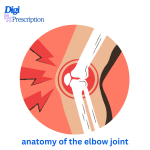
The elbow joint might not be as glamorous as the shoulder or knee, but it’s a highly functional and incredibly complex structure. Whether you're throwing a ball, lifting groceries, or typing this blog post — your elbow is doing a lot of work behind the scenes.
Let’s explore the anatomy of the elbow joint, including its bones, muscles, ligaments, and more.
What Kind of Joint Is the Elbow?
-
Flexion and Extension (bending and straightening the arm)
-
Pronation and Supination (rotating the forearm)
It's actually made up of three articulations enclosed in one joint capsule:
-
Humeroulnar Joint – hinge motion
-
Humeroradial Joint – gliding motion
Bones of the Elbow
Three bones meet to form the elbow joint:
-
Humerus – the upper arm bone
The olecranon (the bony tip of the elbow) is part of the ulna and fits into the humerus to form the hinge.
Muscles Involved in Elbow Movement
Several muscles power the elbow’s movements:
✅ Flexion (bending the elbow)
-
Biceps Brachii
-
Brachialis
-
Brachioradialis
✅ Extension (straightening the elbow)
-
Triceps Brachii
-
Anconeus
✅ Pronation/Supination (forearm rotation)
-
Pronator Teres and Pronator Quadratus
-
Supinator and Biceps Brachii
Ligaments: Stability Providers
The elbow relies on strong ligaments to stay stable during motion:
-
Ulnar Collateral Ligament (UCL) – supports the inner elbow
-
Radial Collateral Ligament (RCL) – supports the outer elbow
-
Annular Ligament – wraps around the head of the radius to allow rotation
These ligaments help prevent dislocation and excessive movement.
Nerves and Blood Supply
The elbow is innervated by three major nerves:
-
Ulnar Nerve – runs behind the medial epicondyle (your “funny bone”)
-
Median Nerve
-
Radial Nerve
Blood supply mainly comes from the brachial artery and its branches.
Clinical Relevance
Understanding elbow anatomy helps identify and manage common injuries like:
-
Tennis Elbow (lateral epicondylitis)
-
Golfer’s Elbow (medial epicondylitis)
-
Elbow Dislocation or Fracture
-
Cubital Tunnel Syndrome
-
Elbow Bursitis
Final Thoughts
The elbow joint may be compact, but it’s a biomechanical powerhouse. From lifting and pushing to rotating and typing — this joint is critical to everyday motion. Knowing its anatomy not only deepens your understanding of how your body works but also helps you prevent injury and promote joint health.
Credible References
-
American Academy of Orthopaedic Surgeons (AAOS) – Elbow Anatomy
https://orthoinfo.aaos.org/en/diseases--conditions/elbow/ -
Cleveland Clinic – Elbow Function and Disorders
https://my.clevelandclinic.org/health/body/21784-elbow -
MedlinePlus – Elbow Joint
https://medlineplus.gov/ency/article/002247.htm -
Johns Hopkins Medicine – Elbow Conditions
https://www.hopkinsmedicine.org/health/conditions-and-diseases/elbow-injuries -
StatPearls – Elbow Joint Anatomy
https://www.ncbi.nlm.nih.gov/books/NBK537066/
